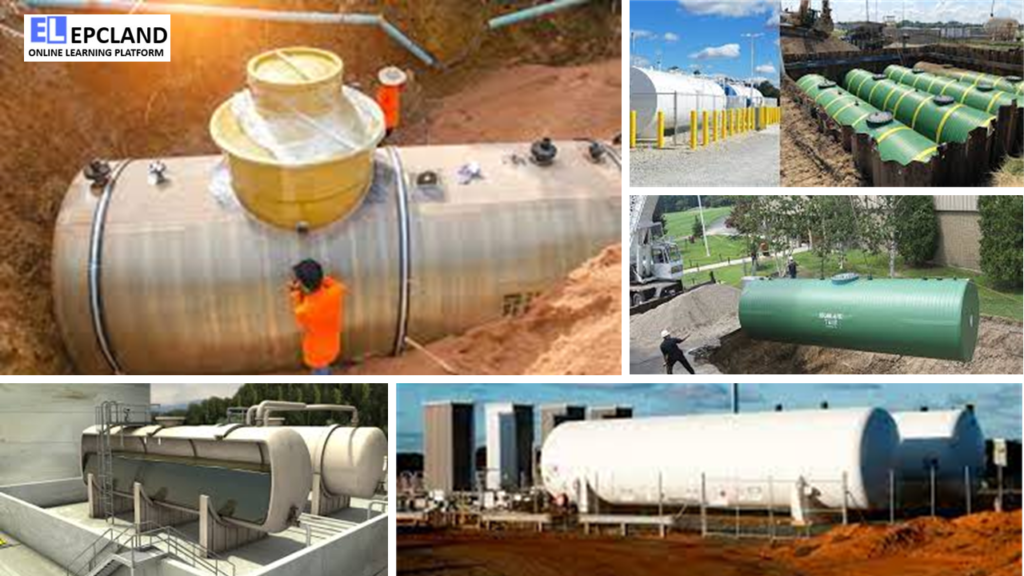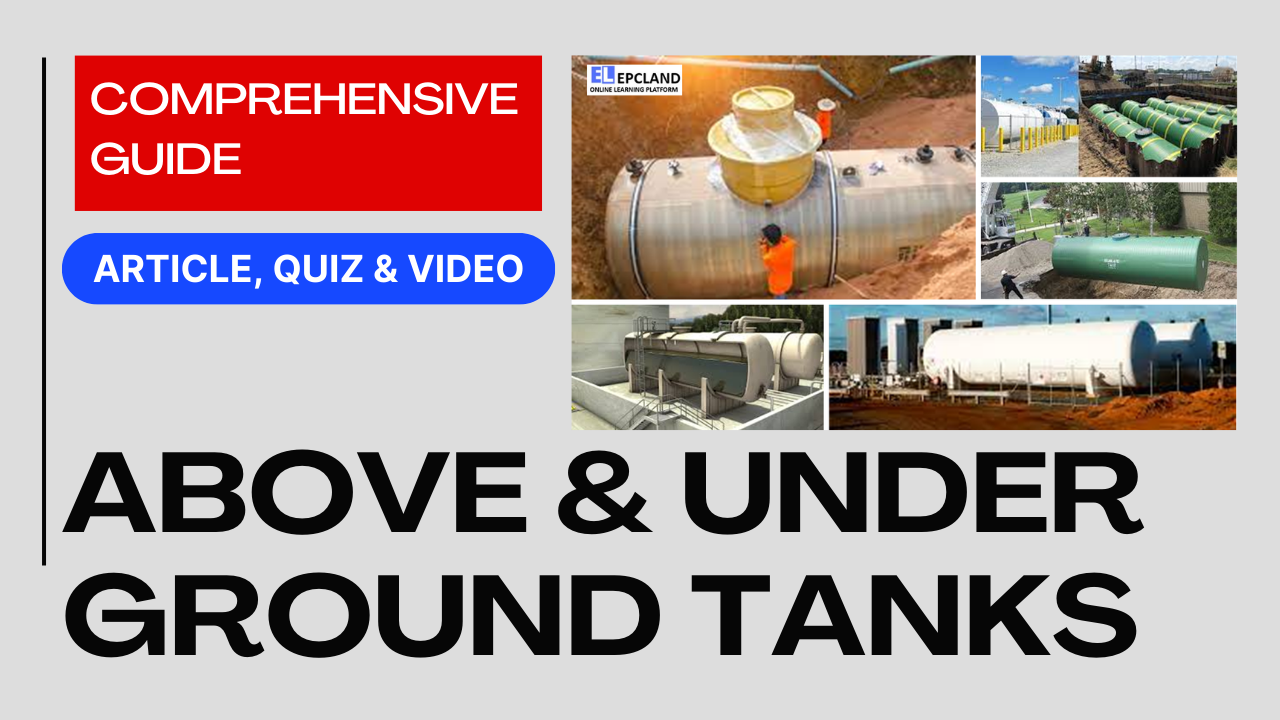Introduction
Above and Underground Storage Tanks are indispensable components of a wide array of industries, serving as repositories for various substances such as petroleum, chemicals, water, and more. The choice between two prominent types of storage tanks, namely Underground Storage Tanks (USTs) and Above-Ground Storage Tanks (ASTs), is a crucial decision that requires a comprehensive understanding of their attributes, benefits, challenges, regulatory implications, maintenance demands, and economic considerations. In this article, we delve deep into the intricacies of USTs and ASTs, conducting a thorough comparison that will equip readers with the insights needed to make informed decisions when selecting the optimal storage solution.
Table of Contents
Do not miss the detailed course on Tank Farm Layout & Stress Analysis
Enrollment link
Check out Similar Articles on other Storage Tanks
Underground Storage Tanks (USTs)
Definition and Types of USTs
Underground Storage Tanks (USTs) are tank systems that are installed below the ground surface, often providing an unobtrusive and space-saving storage solution. USTs come in two primary categories: single-walled USTs and double-walled USTs. Single-walled USTs consist of a single steel shell, whereas double-walled USTs incorporate an additional layer, acting as a secondary containment barrier to prevent leaks.
Table 1: Tank Components
| Component | Single-Walled USTs | Double-Walled USTs |
|---|---|---|
| Primary Container | Steel | Steel |
| Secondary Containment | N/A | Steel or Polymer |

Advantages of USTs
- Space Efficiency and Aesthetics: One of the primary advantages of USTs is their ability to maximize space utilization. By being installed underground, USTs do not occupy valuable surface area. This aspect is particularly beneficial in areas where space is limited, such as densely populated urban environments or locations with stringent zoning regulations.
- Protection from Environmental Elements: The subterranean placement of USTs offers a natural form of protection against harsh environmental conditions. The earth surrounding the tanks provides thermal insulation and shields them from extreme temperatures, thereby reducing the risk of corrosion and structural degradation.
- Reduced Fire Hazard: USTs inherently possess a lower fire risk when compared to their above-ground counterparts. The underground placement of the tanks diminishes the direct exposure to open flames or external heat sources, thus contributing to enhanced fire safety.
Challenges and Concerns
- Corrosion and Leakage Risks: Despite the advantages of underground placement, USTs face inherent challenges related to corrosion. The combination of moisture, soil chemistry, and the presence of certain chemicals can accelerate corrosion processes, potentially leading to the development of leaks.
- Environmental Contamination: One of the most significant concerns associated with USTs is the potential for environmental contamination. Leaks or breaches in the tank walls can result in the release of stored substances, leading to soil and groundwater contamination, which in turn poses a threat to both human health and ecosystems.
- Regulatory Compliance and Monitoring: USTs are subject to stringent regulatory requirements, often necessitating regular inspection, leak detection, and maintenance procedures. Regulatory compliance can be complex due to variations in regulations between federal and state levels.
Do not miss the detailed course on Tank Farm Layout & Stress Analysis
Enrollment link
Above-Ground Storage Tanks (ASTs)
Definition and Types of ASTs
Above-Ground Storage Tanks (ASTs) are tanks situated above the ground surface, offering distinct advantages and considerations in comparison to USTs. ASTs encompass two main categories: vertical ASTs and horizontal ASTs. Vertical ASTs, characterized by their upright orientation, are commonly employed for the storage of liquids, while horizontal ASTs are often utilized for larger volumes of liquids or materials.
Table 2: Tank Components
| Component | Vertical ASTs | Horizontal ASTs |
|---|---|---|
| Container Orientation | Upright | Horizontal |
| Materials | Steel, Concrete | Steel |
Advantages of ASTs
- Ease of Installation and Maintenance: The above-ground positioning of ASTs offers inherent advantages in terms of installation and maintenance. Unlike USTs, which require excavation and specialized installation procedures, ASTs are relatively easier to install, reducing both time and associated costs.
- Inspection and Leak Detection: ASTs offer superior visibility for inspection and leak detection. The fact that these tanks are located above ground level makes it easier to identify potential issues, such as corrosion or damage, thereby enabling prompt maintenance interventions.
- Cost-Effectiveness: The installation costs of ASTs are often lower than those of USTs due to reduced excavation and site preparation requirements. Furthermore, the accessibility of ASTs contributes to easier maintenance procedures, potentially leading to reduced long-term operational costs.
Challenges and Concerns
- Visual Impact and Aesthetics: The most apparent challenge associated with ASTs is their potential visual impact on the surrounding environment. The above-ground presence of these tanks can sometimes be deemed unsightly, particularly in scenic or residential areas.
- Vulnerability to Environmental Elements: ASTs are exposed to a wide range of environmental elements, including sunlight, rain, snow, and wind. While this exposure can lead to corrosion and other forms of material degradation, appropriate protective coatings can mitigate these effects.
- Fire Risk and Safety Measures: Due to their above-ground placement, ASTs are inherently more vulnerable to fire hazards than USTs. As a result, effective fire prevention and suppression systems are essential to ensure the safety of personnel, property, and the environment.
Environmental Impact and Regulatory Compliance
Given the potential for environmental contamination and associated hazards, both USTs and ASTs are subject to stringent regulatory frameworks aimed at minimizing risks.
Regulatory Framework for USTs
In the United States, USTs are governed by a combination of federal and state regulations. The federal regulations, often established by the Environmental Protection Agency (EPA), serve as a baseline, while state-level regulations may further refine requirements based on specific regional considerations.
Regulatory Framework for ASTs
ASTs are subject to regulations that share similarities with UST regulations. However, the above-ground nature of these tanks introduces nuances that are addressed through specific standards and codes. For instance, the American Petroleum Institute’s API 650 standard provides guidelines for the design and construction of welded steel tanks, including ASTs.
Table 3: Codes and Standards
| Tank Type | Relevant Standards and Codes |
|---|---|
| USTs | EPA Regulations, State-Level Regulations |
| ASTs | API 650, EPA Regulations, State Standards |
Maintenance and Monitoring
Effective maintenance and monitoring strategies are imperative to ensure the structural integrity of storage tanks and prevent leaks, corrosion, and other operational challenges.
Maintenance Requirements for USTs
Due to their underground placement, USTs require proactive corrosion prevention and mitigation measures. Cathodic protection systems, which involve the use of sacrificial anodes, are commonly employed to counteract the corrosive effects of soil and groundwater.
Maintenance Requirements for ASTs
ASTs demand consistent maintenance efforts to address potential issues associated with their exposure to environmental elements. Protective coatings, regular inspections, and timely repairs are essential to extend the operational life of these tanks.
Monitoring Systems for USTs
Monitoring USTs for leaks and other anomalies is critical to prevent environmental contamination. Automatic tank gauging (ATG) systems, which use sensors to measure liquid levels and detect potential leaks, are commonly employed in USTs.
Monitoring Systems for ASTs
ASTs benefit from various monitoring technologies designed to provide real-time data about tank conditions. Continuous level monitoring systems, combined with advanced sensors and telemetry solutions, enable operators to respond swiftly to any abnormalities.
Do not miss the detailed course on Tank Farm Layout & Stress Analysis
Enrollment link
Cost Considerations for Above and Underground Storage Tanks
The economic implications of choosing between USTs and ASTs encompass various factors, including installation costs, operational expenses, and long-term maintenance considerations.
Installation Costs for USTs
The installation of USTs involves several components, including excavation, site preparation, tank and piping installation, and environmental assessments. The complexity of these processes can lead to higher initial installation costs.
Installation Costs for ASTs
ASTs often offer cost advantages in terms of installation. The absence of excavation and the relative simplicity of site preparation contribute to reduced upfront costs, making ASTs an attractive option for budget-conscious projects.
Operation and Maintenance Costs
Operational and maintenance costs differ between USTs and ASTs due to factors such as accessibility, maintenance requirements, and regulatory compliance.
USTs
Operational costs for USTs involve ongoing leak detection, regular inspections, and adherence to regulatory requirements. Additionally, the potential need for corrective action in the event of a leak can result in substantial financial implications.
ASTs
While ASTs may have lower initial installation costs, operational and maintenance expenses can accrue over time. Routine inspections, protective coatings, and other maintenance efforts contribute to these costs. However, the ease of access to above-ground tanks can potentially result in cost savings associated with maintenance interventions.
Case Studies for Above and Underground Storage Tanks
UST Implementation Case Study
At a petroleum storage facility, the decision to employ double-walled USTs showcased a proactive approach to leak prevention. By opting for a design that included a secondary containment barrier, the facility mitigated the risk of leaks reaching the environment. Furthermore, advanced leak detection systems, such as electronic sensors and automatic tank gauging (ATG) technology, were integrated to provide real-time monitoring of tank conditions.
AST Implementation Case Study
A chemical processing plant’s adoption of vertical ASTs demonstrated the advantages of above-ground storage in an industrial setting. The facility emphasized the importance of real-time monitoring through the implementation of sophisticated sensors and telemetry systems. Regular inspections and maintenance interventions were also prioritized, resulting in an exemplary track record of leak prevention and operational reliability.
Comparative Analysis
Comparing the two case studies sheds light on the versatility of both USTs and ASTs in various contexts. While the petroleum storage facility leveraged the inherent advantages of USTs, such as their potential for discreet placement, the chemical processing plant showcased the benefits of above-ground storage through enhanced monitoring capabilities and simplified maintenance procedures. The choice between USTs and ASTs ultimately hinges on a comprehensive assessment of factors such as the nature of stored materials, site characteristics, regulatory requirements, and long-term maintenance considerations.
Comparison between Above and Underground Storage Tanks
Detailed comparison between Underground Storage Tanks (USTs) and Above-Ground Storage Tanks (ASTs) based on various factors:
Table 4: Comparison Between Underground Storage Tanks (USTs) and Above-Ground Storage Tanks (ASTs)
| Aspect | Underground Storage Tanks (USTs) | Above-Ground Storage Tanks (ASTs) |
|---|---|---|
| Installation | Requires excavation and site preparation | Simpler installation process |
| Visibility | Hidden underground, minimal visual impact | More visible, potential visual impact |
| Space Utilization | Maximizes space by being buried | Requires surface space |
| Protection | Shielded from environmental elements | Exposed to environmental conditions |
| Corrosion Risk | Prone to corrosion due to soil and moisture | Requires protective coatings |
| Leak Detection | Complex leak detection due to concealment | Easier leak detection and inspection |
| Fire Hazard | Lower fire risk due to underground placement | Higher fire risk, necessitates safety measures |
| Regulatory Compliance | Complex regulatory compliance due to concealment | Similar regulatory framework as USTs |
| Environmental Impact | Risk of groundwater and soil contamination | Potential for spills impacting surroundings |
| Maintenance | Complex maintenance due to underground positioning | Easier maintenance, above-ground accessibility |
| Costs (Installation) | Higher installation costs due to excavation | Lower installation costs due to accessibility |
| Costs (Operation) | Potential for higher operation costs due to leaks | Operational costs associated with maintenance |
| Flexibility | Limited flexibility due to underground placement | Relatively more flexibility in placement |
| Future Innovations | Evolving leak detection technology | Advanced monitoring and sustainability |
This table provides a comprehensive comparison between USTs and ASTs, highlighting their differences in terms of installation, visibility, protection, maintenance, regulatory compliance, environmental impact, costs, and more. Keep in mind that the choice between USTs and ASTs should be made based on the specific requirements, constraints, and priorities of the project or application.
Do not miss the detailed course on Tank Farm Layout & Stress Analysis
Enrollment link
Future Trends and Innovations on Above and Underground Storage Tanks
As technology continues to advance, the storage tank industry is witnessing ongoing innovations that are shaping the future of storage solutions.
Advancements in UST Technology
In response to the challenges posed by corrosion and leaks, UST technology is evolving with a focus on enhanced materials and advanced leak detection methods. High-performance coatings and linings, combined with improved corrosion-resistant alloys, contribute to extended tank lifespans. Additionally, the integration of real-time monitoring systems allows for early leak detection, minimizing the potential for environmental impact.
Innovations in AST Design
ASTs are also experiencing significant advancements, particularly in the realm of design and functionality. With an increasing emphasis on environmental sustainability, ASTs are being engineered to incorporate features such as rainwater harvesting systems and secondary containment solutions. Furthermore, the integration of Internet of Things (IoT) technology is revolutionizing monitoring capabilities, enabling operators to receive real-time data on tank conditions and make data-driven decisions to optimize operational efficiency.
Conclusion on Above and Underground Storage Tanks
In the realm of storage tanks, the choice between Underground Storage Tanks (USTs) and Above-Ground Storage Tanks (ASTs) entails a comprehensive evaluation of numerous factors, including environmental impact, regulatory compliance, maintenance requirements, and economic considerations. Each type of tank presents a distinct set of advantages and challenges, making an informed decision crucial. By delving deep into the intricacies of USTs and ASTs, stakeholders can make choices that align with their specific operational needs, regulatory obligations, and sustainability goals. Ultimately, the selection of an appropriate storage solution contributes not only to the safety of personnel and the environment but also to the efficient and reliable functioning of industrial processes and infrastructure.
FAQs on Above and Underground Storage Tanks
FAQ 1: What are Underground Storage Tanks (USTs) and Above-Ground Storage Tanks (ASTs)?
Answer: USTs are tanks that are installed beneath the ground surface to store various substances such as petroleum and chemicals. They come in single-walled and double-walled variations, with the latter having an additional layer for leak prevention. On the other hand, ASTs are tanks positioned above the ground surface, available in vertical and horizontal orientations. Vertical ASTs are commonly used for liquids, while horizontal ASTs are suitable for larger volumes.
FAQ 2: What are the main advantages of USTs and ASTs?
Answer: USTs offer space efficiency, protection from environmental elements, and reduced fire hazard due to their underground placement. ASTs, on the other hand, provide easier installation and maintenance, improved inspection and leak detection capabilities, and generally lower installation costs.
FAQ 3: What are the primary challenges associated with USTs and ASTs?
Answer: USTs face challenges like corrosion and leakage risks due to soil exposure, potential environmental contamination from leaks, and complex regulatory compliance. ASTs are vulnerable to environmental elements, might have a higher fire risk, and can impact aesthetics due to their visibility.
FAQ 4: How are USTs and ASTs regulated?
Answer: Both USTs and ASTs are subject to regulatory frameworks that vary by jurisdiction. USTs are governed by federal and state regulations, with the EPA overseeing standards at the federal level. ASTs adhere to similar regulations but also follow industry-specific standards such as API 650 for welded steel tanks.
FAQ 5: What should be considered when choosing between USTs and ASTs?
Answer: The decision depends on factors like the nature of stored materials, available space, visual impact, fire safety measures, environmental impact, and maintenance costs. Assessing these factors in line with project requirements and regulatory obligations is essential to make an informed choice between USTs and ASTs.
Recommended courses (Published on EPCLand)
- Basics of Piping Engineering
- Piping Layout Engineering
- Piping Material Engineering
- Piping Stress Analysis
- Complete Course on Piping Engineering
- Material Requisitions
- Piping Material Specifications
- Valve Material Specifications
Don’t miss the published articles on following:
Related Video
Attempt Quiz
Question 1:
What is the primary purpose of above-ground storage tanks?
Explanation: The primary purpose of above-ground storage tanks is to store liquids, such as petroleum products, chemicals, and water, above the ground surface.
Question 2:
What is cathodic protection in the context of underground storage tanks?
Explanation: Cathodic protection is a technique used to prevent corrosion of the bottom surface (tank bottom) of underground storage tanks by using sacrificial anodes or impressed current systems.
Question 3:
Which factor is important when designing secondary containment for above-ground storage tanks?
Explanation: Designing secondary containment for above-ground storage tanks is important to address the potential for environmental spills and leaks, helping to prevent soil and water contamination.
Question 4:
What type of material is commonly used for above-ground storage tank construction?
Explanation: Steel is a common material used for above-ground storage tank construction due to its strength, durability, and suitability for holding various types of liquids.
Question 5:
What is the purpose of internal coatings for storage tanks?
Explanation: Internal coatings are applied to storage tanks to prevent corrosion and chemical reactions between the stored liquids and the tank material, helping to maintain the integrity of the tank and the quality of the stored contents.



